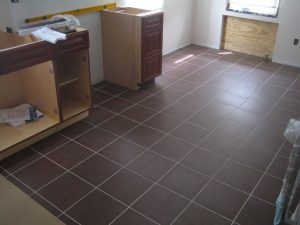
Taking on a project of this size the first time around was a big challenge with a steep learning curve.
Before starting, I took my time to learn all of the concepts of tiling a floor and did extensive research.
This kitchen is about 225 Sq/ft with 4 different doorways. After pulling up the old linoleum floor, I needed to pull up the substrate and get down to the 1×4 boards laying on the joists. This house is over 70 years old and the 1×4 boards were in good condition. The joists are rough cut 2 ½ x 8s.
Subfloor and Substrate
I put down 1/2″ plywood all around in a staggered pattern being careful not to put screws in directly to the joists. The concern being if the floor shifts, it may buckle in areas and affect the finished floor. It took a little bit of measuring and careful consideration with all 4 doorways.
If you are unfamiliar with subfloors and tiling I strongly urge you to buy the book Tile Your World: John Bridge’s New Tile Setting Book![]() . Without this book, I am sure my floor would have been a failure. He also has a tiling forum which is extremely helpful.
. Without this book, I am sure my floor would have been a failure. He also has a tiling forum which is extremely helpful.
I learned a lot about the underlying structure and anatomy of floor structure. You need to make sure the floor is stable enough to hold a tile floor or else it will be prone to cracking. There is good coverage about Ditra and the product line which is helpful as well. I also have a few other tiling books, but this is the best book on tiling.
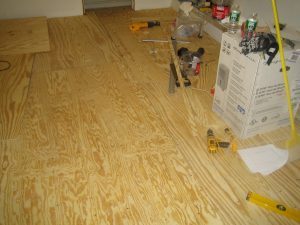
Plywood in place
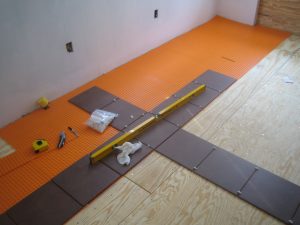
Laying out tiles to get a visual and “feel”
After the subfloor was put down, I decided to go with the Schluter Ditra![]() . I liked this idea of it “decoupling” the tiles from the substrate. I was sold on the concept and all of the Engineering work that the folks at Schluter put behind this product (Also check out their entire product line, as they continue to innovate products for the tiling industry).
. I liked this idea of it “decoupling” the tiles from the substrate. I was sold on the concept and all of the Engineering work that the folks at Schluter put behind this product (Also check out their entire product line, as they continue to innovate products for the tiling industry).
I used VersaBond Grey Mortar![]() with a 1/4″ square notched trowel. After researching, I found that Versabond was the best thinset for Ditra to plywood.
with a 1/4″ square notched trowel. After researching, I found that Versabond was the best thinset for Ditra to plywood.
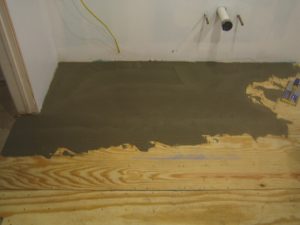
Putting down Versabond
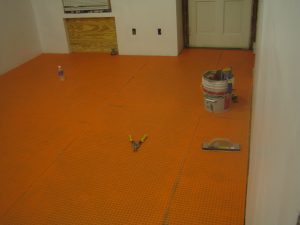
Ditra installed
I started in a corner of the room which would be covered by cabinets in case I ran into any issues. The mix was a little on the fluid side (like a thick soup) and went down pretty easily.
It’s a good idea to measure out your Ditra sheets ahead of time and do a dry fit. It is very easy to work with and cut with a utility knife. There are small 1/8″ gaps between Ditra sheets throughout the floor. I let it dry for a few days.
Once the Ditra is dried and set, I kind of didn’t want to cover it. Where else can you have a bright orange floor ?! It was cool just to walk around on it.
Tiling the Floor
We used Porcelain tile for this room. One thing I like about porcelain is that it is the same color all the way through, so if it ever chips or breaks, it isn’t as apparent as if you were to chip beige ceramic tile with an orange core. P
Porcelain is usually a more rugged tile in how it is cured. This will differ in the different types, quality and prices. After working with porcelain, I would not go to ceramic for floors.
You need to write out a tile schedule before starting to mix any thinset. I went through this a number of times and checked my numbers thoroughly. The Tile your world book is great for breaking this down for the novice and also explains the why you need to do this part.
I also laid out tiles on the floor just to get an idea of what it would look like. I was toying with the idea of a diamond pattern, but after some consideration, I figured I would have bitten off more than I could chew.

You want to be able to have full or half tiles at the end of the room or transitions. In the end, I had 1 of the 4 entryways a little off with a sliver of tile.
I was not concerned though because it would be covered up by a wooden transition piece as it leads to the oak floor in the next room.
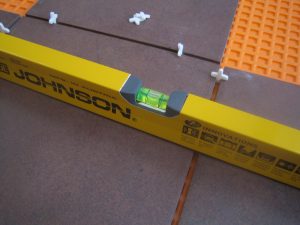
Grouting
This was one of my main concerns as I’ve seen too many botched jobs where there is a haze all over the tiles after the job is complete. Also, while doing my research, I found a lot of people asking for help and options on what they can do to remove the haze after it dried on their floors.
Some recommendations are to use a good cheesecloth and some form of acid if it is really bad. After reading that, I wanted to make sure I didn’t miss as it didn’t sound like a job a professional tile setter would opt for.
The key was a bunch of tile sponges and constantly wringing out the sponges after every few wipes. The sponges have to be damp, not wet. This is really important because if it is too wet, you end up pulling/moving some of the grout out of the cracks. It is also a good idea to change the water frequently.
You also end up just smearing the grout around the surface rather than pick it up from the tiles. Most hardware stores will sell a 5 or 6 pack of sponges which is very helpful. I think I blasted through the whole pack. You do have to watch this step, because even after wiping it clean, as the water dried, the haze revealed itself. So cover small sections at a time.
After mixing up a small batch of grout, I started in the with the same small section I did with the initial Ditra install in case I botched it, it would be covered by cabinets. This is where I learned about the damp vs. wet sponges I mentioned above.
From there on, go section by section and keep switching out the dirty water for a fresh bucket. After finishing the floor, I went over sections again and again where I thought I saw a slight haze.
At this point, I was still a little concerned what it would end up looking like when it completely dried for a full day. Fortunately it worked out well and the floor looked great.
After 15+ years, the floor has held up with no cracks or problems.
Hopefully you can take some ideas and info out of here if you are considering tiling your own floor or looking to hire someone to do a job for you.
Thanks for reading,
Scottie
